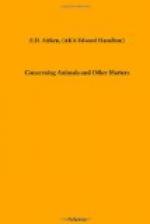To return to those birds and beasts with standard feet, I find that the first outside purpose for which they find them serviceable is to scratch themselves. This is a universal need. But a foot is handy in many other ways. A hen and chickens, getting into my garden, transferred a whole flower-bed to the walk in half an hour. Yet a bird trying to do anything with its foot is like a man putting on his socks standing, and birds as a race have turned their feet to very little account outside of their original purpose. Such a simple thing as holding down its food with one foot scarcely occurs to an ordinary bird. A hen will pull about a cabbage leaf and shake it in the hope that a small piece may come away, but it never enters her head to put her foot on it. In this and other matters the parrot stands apart, and also the hawk, eagle, and owl; but these are not ordinary birds.
Beasts, having twice as many feet as birds, have learned to apply them to many uses. They dig with them, hold down their food with them, fondle their children with them, paw their friends, and scratch their enemies. One does more of one thing and another of another, and the feet soon show the effects of the occupation, the claws first, then the muscles, and even the bones dwindling by disuse, or waxing stout and strong. Then the joy of doing what it can do well impels the beast further on the same path, and its offspring after it.
[Illustration: THE NOSE OF THE ELEPHANT BECOMING A HAND HAS REDEEMED ITS MIND]
And this leads at last to specialism. The Indian black bear is a “handy man,” like the British Tar—good all round. Its great soft paw is a very serviceable tool and weapon, armed with claws which will take the face off a man or grub up a root with equal ease. When a black bear has found an ant-hill it takes but a few minutes to tear up the hard, cemented clay and lay the deep galleries bare; then, putting its gutta-percha muzzle to the mouth of each, it draws such a blast of air through them that the industrious labourers are sucked into its gullet in drifts. Afterwards it digs right down to the royal chamber, licks up the bloated queen, and goes its way.
But there is another worker in the same mine which does not go to work this way. The ant-eater found fat termites so satisfying that it left all other things and devoted its life to the exploiting of anthills, and now it has no rival at that business, but it is fit for nothing else. Its awkward digging tools will not allow it to put the sole of its foot to the ground, so it has to double them under and hobble about like a Chinese lady. It has no teeth, and stupidity is the most prominent feature of its character. It has become that poor thing, a man of one idea.




